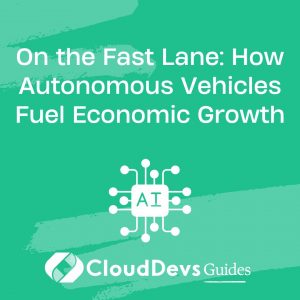On the Fast Lane: How Autonomous Vehicles Fuel Economic Growth
In the rapidly evolving world of technology, autonomous vehicles have emerged as one of the most exciting and disruptive innovations. Self-driving cars, driven by artificial intelligence (AI), have the potential to transform the way we commute, reducing accidents, traffic congestion, and carbon emissions. However, developing AI for autonomous vehicles presents a complex set of challenges and opportunities that demand attention. In this in-depth exploration, we will dive into the world of AI development for autonomous vehicles, dissecting the hurdles and the promising horizons that await.
1. Challenges
1.1. Safety as the Top Priority
Safety is the cornerstone of autonomous vehicle development. These vehicles must navigate complex urban environments, interact with human-driven cars, and make real-time decisions to avoid accidents. Achieving the level of safety required is a monumental challenge. Companies like Waymo, a subsidiary of Alphabet Inc., are at the forefront of addressing this challenge. Waymo has amassed millions of real-world miles driven by autonomous vehicles, enabling them to fine-tune their AI algorithms for safety.
[Learn more about Waymo’s approach to safety](https://waymo.com/safety)
1.2. Data Privacy Concerns
Autonomous vehicles generate massive amounts of data, including sensor readings, maps, and user information. While data is crucial for training AI models, it raises significant privacy concerns. Striking the right balance between data utilization for improving AI algorithms and respecting user privacy is a delicate tightrope act that developers must navigate.
[Read about the privacy concerns surrounding autonomous vehicles](https://www.wired.com/story/self-driving-cars-data-privacy/)
2.3. Regulatory Hurdles
Regulations vary widely between regions and countries, making it a complex endeavor to develop autonomous vehicles for global deployment. Navigating this regulatory maze requires substantial effort and resources. For instance, understanding and complying with the Federal Automated Vehicles Policy in the United States is essential for companies operating in this space.
[Explore the regulatory challenges faced by autonomous vehicle developers](https://www.reuters.com/article/us-autos-autonomous-regulation-analysis-idUSKBN1ZE0UP)
2. Opportunities
2.1. Revolutionizing Transportation
The primary promise of autonomous vehicles is to revolutionize transportation. They have the potential to significantly reduce traffic congestion, which costs individuals and businesses billions of dollars annually. By optimizing routes and coordinating with other autonomous vehicles, traffic jams could become a relic of the past.
2.2. Economic Growth and Job Opportunities
The development of autonomous vehicles creates a plethora of job opportunities in AI development, sensor technology, vehicle manufacturing, and more. Beyond job creation, it can lead to substantial cost savings for businesses and consumers alike. Moreover, autonomous vehicles have the potential to boost productivity as people can work or relax during their commutes.
[Explore the economic potential of autonomous vehicles](https://www.brookings.edu/research/ten-facts-about-autonomous-vehicles/)
2.3. Environmental Impact
As we confront the urgent need to address climate change, autonomous vehicles can play a significant role. AI-driven systems can optimize driving patterns and routes, reducing fuel consumption and carbon emissions. This technology could contribute to a greener and more sustainable future, aligning with global efforts to combat climate change.
[Learn about the environmental benefits of autonomous vehicles](https://www.nature.com/articles/s41598-020-78542-9)
Conclusion
AI development for autonomous vehicles is a thrilling journey filled with challenges and opportunities. While ensuring safety, addressing data privacy concerns, and navigating regulatory landscapes are formidable tasks, the potential rewards are immense. From safer roads and reduced traffic congestion to economic growth and environmental benefits, the impact of autonomous vehicles driven by AI promises to be profound.
As technology continues to advance, it falls upon developers, regulators, and innovators to work hand in hand, shaping a future where autonomous vehicles become a safe and accessible reality for all.
Table of Contents









